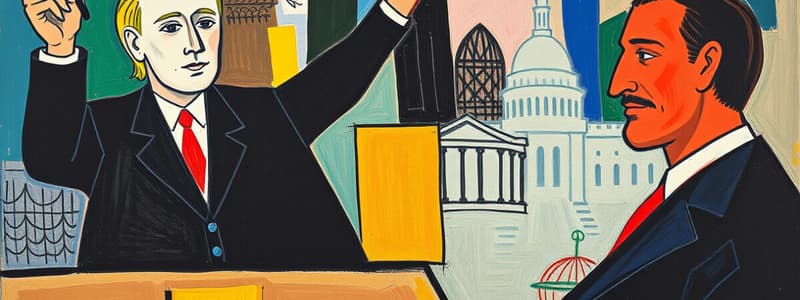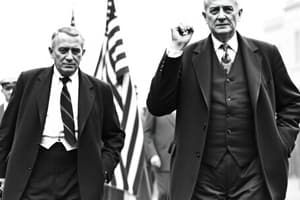Podcast
Questions and Answers
Which of the following Presidents were Republicans in the 1920s? (Select all that apply)
Which of the following Presidents were Republicans in the 1920s? (Select all that apply)
- Calvin Coolidge (correct)
- Franklin D. Roosevelt
- Warren G. Harding (correct)
- Herbert Hoover (correct)
What economic state is characterized by growth, rising profits, and full employment?
What economic state is characterized by growth, rising profits, and full employment?
Prosperity
What national policy did the U.S. return to after WWI?
What national policy did the U.S. return to after WWI?
Isolationism
Who was the Republican President elected in 1920 whose slogan was 'Return to Normalcy'?
Who was the Republican President elected in 1920 whose slogan was 'Return to Normalcy'?
What was the group of friends and political allies of Warren G. Harding called?
What was the group of friends and political allies of Warren G. Harding called?
Who was the Republican Secretary of State during the 1920s promoting an isolationist policy?
Who was the Republican Secretary of State during the 1920s promoting an isolationist policy?
Who was the Secretary of Treasury under Harding and Coolidge and chief architect of the hands-off government approach?
Who was the Secretary of Treasury under Harding and Coolidge and chief architect of the hands-off government approach?
The policy that government should interfere as little as possible in the nation's economy is called ______.
The policy that government should interfere as little as possible in the nation's economy is called ______.
Who was the ex-President nominated to be Chief Justice of the Supreme Court by Harding?
Who was the ex-President nominated to be Chief Justice of the Supreme Court by Harding?
What Supreme Court case invalidated Muller v. Oregon, stating women were equal to men and undeserving of special protection?
What Supreme Court case invalidated Muller v. Oregon, stating women were equal to men and undeserving of special protection?
What was the Veterans Bureau created for?
What was the Veterans Bureau created for?
What was the veterans' group that promoted patriotism and benefits for former servicemen called?
What was the veterans' group that promoted patriotism and benefits for former servicemen called?
What term refers to the reduction of the size of the military and weapons?
What term refers to the reduction of the size of the military and weapons?
What treaty did the U.S. agree to in 1928 to abandon war as a means to settle disputes?
What treaty did the U.S. agree to in 1928 to abandon war as a means to settle disputes?
What tariff law raised tariffs on manufactured goods in the 1920s?
What tariff law raised tariffs on manufactured goods in the 1920s?
What scandal involved Secretary of Veterans Affairs Charles Forbes selling supplies from veterans' hospitals?
What scandal involved Secretary of Veterans Affairs Charles Forbes selling supplies from veterans' hospitals?
What was the Teapot Dome Scandal?
What was the Teapot Dome Scandal?
Who was Albert B. Fall?
Who was Albert B. Fall?
Who was Harry Daugherty?
Who was Harry Daugherty?
What nickname was Calvin Coolidge known by?
What nickname was Calvin Coolidge known by?
What type of tractors were mass-produced in the 1920s powered by gasoline?
What type of tractors were mass-produced in the 1920s powered by gasoline?
Flashcards are hidden until you start studying
Study Notes
1920's Republican Presidents
- Presidents Warren G. Harding, Calvin Coolidge, and Herbert Hoover implemented supply-side economic policies and endorsed a laissez-faire approach.
Prosperity
- The 1920s were characterized by strong economic growth, marked by rising profits and high employment rates.
Isolationism
- Aimed at refraining from foreign entanglements, U.S. isolationism prevailed after WWI and persisted until WWII.
Warren G. Harding
- Elected in 1920 advocating for a "Return to Normalcy" but faced numerous scandals before his death in 1923.
Ohio Gang
- A group of Harding's Ohio associates given influential government positions, leading to significant political corruption during his presidency.
Charles Evan Hughes
- Served as Secretary of State, emphasizing an isolationist foreign policy during the 1920s.
Andrew W. Mellon
- Served as Treasury Secretary, he was instrumental in establishing a hands-off government approach and promoting supply-side economics.
Laissez-faire
- The principle of minimal government intervention in the economy, characteristic of the 1920s Republican administrations.
William H. Taft
- Nominated by Harding to be Chief Justice in 1921 and served until shortly before his death in 1930.
Adkins v. Children's Hospital
- Supreme Court ruling that invalidated special protections for women in the workplace, declaring gender equality under the law.
Veterans Bureau
- Established in 1921 to provide essential services and healthcare to disabled veterans.
The American Legion
- A veterans’ organization formed post-WWI focused on promoting patriotism and advancing the interests of servicemen.
Disarmament
- A policy aiming to decrease military size and weaponry, reflective of the isolationist stance in the 1920s.
Washington Conference
- A pivotal 1921 meeting resulting in disarmament agreements, including the Five-Power Naval Limitation Treaty.
Kellogg-Briand Pact
- A 1928 treaty where the U.S. and other nations agreed to renounce war as a method for resolving disputes.
Fordney-McCumber Tariff Law
- Enacted in 1922 and 1930, resulting in high tariffs on manufactured goods, which favored domestic industry but restricted foreign trade.
Forbes Scandal
- A major corruption case involving Veterans Affairs Secretary Charles Forbes, who illegally profited from selling medical supplies.
Teapot Dome Scandal
- A significant political scandal involving Secretary of the Interior Albert Fall, who was convicted of bribery related to oil leases.
Albert B. Fall
- The first cabinet member to be convicted of a crime while in office, charged with accepting bribes during the Teapot Dome Scandal.
Harry Daugherty
- U.S. Attorney General associated with the Ohio Gang, forced to resign due to corruption involving illegal liquor licenses and bribes.
Calvin Coolidge
- Ascended to presidency in 1923 after Harding's death, known as "Silent Cal" and maintained a pro-business, laissez-faire economic policy.
Gasoline-Engine Tractor
- The mass production of gasoline-powered tractors in the 1920s revolutionized agriculture, leading to increased mechanization in farming.
Studying That Suits You
Use AI to generate personalized quizzes and flashcards to suit your learning preferences.




